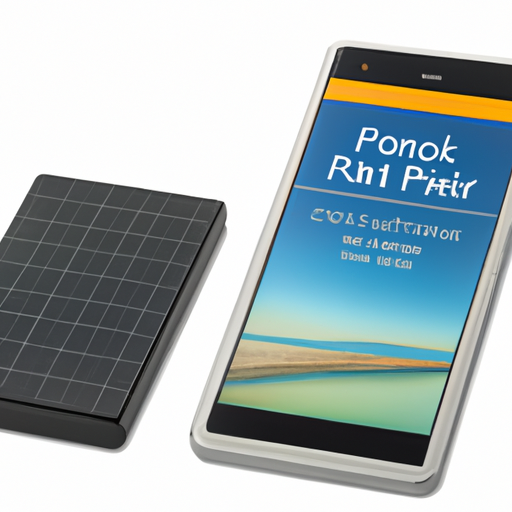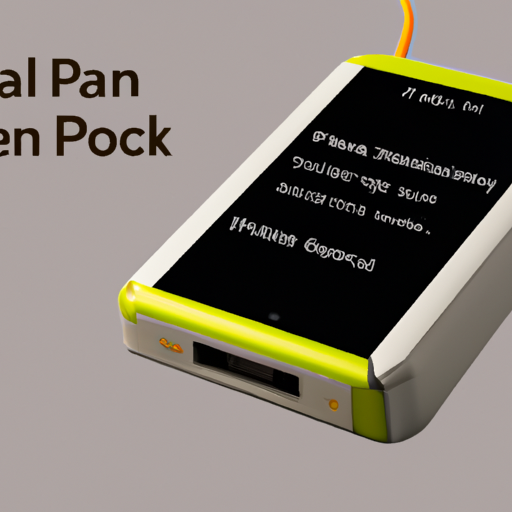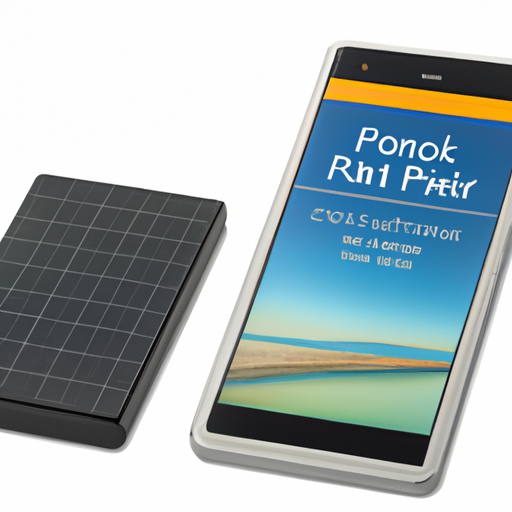

Have you ever wondered how long it takes to charge a power bank using portable solar panels? Well, you’re in luck because we’re going to dive into all the details! Charging your power bank with solar energy is a great way to keep your devices juiced up while on the go, but it’s important to understand how long it will take to get a full charge. In this article, we’ll discuss the factors that can affect the charging time, such as the capacity of your power bank and the efficiency of the solar panels. So, if you’re interested in learning more about the average charging time for a power bank using portable solar panels, keep reading!
The charging time for a power bank using portable solar panels can vary depending on a few factors. Firstly, the capacity of your power bank plays a crucial role. A power bank with a larger capacity will generally take longer to charge than one with a smaller capacity. Additionally, the efficiency of the solar panels you’re using also impacts the charging time. High-quality solar panels will be able to convert more sunlight into energy, resulting in a faster charging time. Another factor to consider is your location and the amount of sunlight available. In areas with abundant sunlight, you can expect a quicker charging time compared to places with less sunlight. So, if you want to learn more about the average charging time for a power bank using portable solar panels and how to maximize its efficiency, keep reading the rest of this article!


Factors Affecting Charging Time
When it comes to charging a power bank using portable solar panels, there are several factors that can affect the charging time. Understanding these factors can help you optimize your charging setup and ensure that you get the most out of your solar-powered charging system.
Efficiency of Solar Panels
The efficiency of the solar panels you are using plays a crucial role in determining the charging time for your power bank. Solar panels work by converting sunlight into electricity, and the efficiency of this conversion process can vary depending on the type and quality of the solar panels.
Higher-efficiency solar panels are able to convert a larger percentage of sunlight into usable electricity. This means that they can charge your power bank faster, as more energy is being generated from the same amount of sunlight. It is important to invest in high-quality solar panels with a good efficiency rating to optimize your charging time.
Sunlight Intensity and Duration
The amount of sunlight available to your solar panels is another important factor. Sunlight intensity refers to the strength of the sunlight, while sunlight duration refers to the number of hours of sunlight available in a day. Both of these factors can affect the charging time for your power bank.
If you are in a location with strong sunlight intensity and long hours of sunshine, your solar panels will be able to generate more electricity in a shorter amount of time, resulting in faster charging for your power bank. On the other hand, if you are in a location with weak sunlight intensity or limited hours of sunshine, charging your power bank using solar panels may take longer.
Battery Capacity of Power Bank
The battery capacity of your power bank is another factor to consider when determining the charging time. Power banks come in different capacities, ranging from small ones that can charge a smartphone once or twice, to larger ones that can charge multiple devices multiple times.
A higher-capacity power bank will take longer to charge compared to a smaller one, as it requires more energy to fill up its larger battery. It is important to take into account the capacity of your power bank when estimating the charging time using portable solar panels.
Calculating Charging Time
To estimate the charging time for your power bank using portable solar panels, you need to consider several factors: the wattage of the solar panels, the capacity of the power bank, and the battery charging efficiency.
Solar Panel Wattage
The wattage of the solar panels you are using is an important factor in determining the charging time. The wattage refers to the amount of power that the solar panels can generate under specific conditions. Higher-wattage solar panels can generate more electricity, resulting in faster charging times.
It is important to note that the wattage of the solar panels is not the only factor that determines how much electricity they can generate. The efficiency of the solar panels, as mentioned earlier, also plays a significant role.
Power Bank Capacity
The capacity of your power bank refers to the amount of energy it can store. It is usually measured in milliampere-hours (mAh) or watt-hours (Wh). The higher the capacity of the power bank, the longer it takes to charge.
To calculate the charging time, you need to divide the capacity of your power bank by the wattage of the solar panels. This will give you an estimate of the number of hours required to fully charge your power bank under optimal conditions.
Battery Charging Efficiency
The battery charging efficiency is another factor that affects the charging time. It refers to the percentage of energy from the solar panels that actually gets stored in the power bank’s battery. The efficiency can vary depending on the quality of the power bank and its charging circuitry.
A higher charging efficiency means that a larger percentage of the energy generated by the solar panels is being stored in the power bank, resulting in faster charging. It is important to choose a power bank with good charging efficiency to minimize the charging time.
Types of Solar Panels
When it comes to portable solar panels, there are several types to choose from. Each type has its own advantages and disadvantages, which can affect the charging time and overall performance.
Monocrystalline Solar Panels
Monocrystalline solar panels are made from a single crystal structure, usually silicon. They are known for their high efficiency and excellent performance in low-light conditions. Monocrystalline panels tend to be more expensive than other types but offer faster charging times and better overall performance.
Polycrystalline Solar Panels
Polycrystalline solar panels are made from multiple smaller crystal structures, also usually silicon. They are less expensive to manufacture compared to monocrystalline panels but have slightly lower efficiency ratings. However, the difference in efficiency is minimal, and polycrystalline panels offer good performance and charging times.
Thin-Film Solar Panels
Thin-film solar panels are a lightweight and flexible option. They are made by depositing a thin layer of semiconducting material on a backing material such as glass, metal, or plastic. Thin-film panels tend to have lower efficiency ratings compared to crystalline panels but can still provide sufficient charging power for power banks.
When choosing the right type of solar panel for your portable charging setup, consider factors such as cost, efficiency, durability, and weight. It is important to find a balance between these factors based on your specific needs and requirements.


Common Solar Panel Setups
There are several common solar panel setups that can be used for charging power banks. Each setup has its own advantages and can be chosen based on factors such as portability, ease of use, and charging efficiency.
Fixed Solar Panel Setup
A fixed solar panel setup is a permanent installation of solar panels in a fixed location, such as on a rooftop or a dedicated solar panel stand. This setup provides a stable and reliable source of solar power and is ideal for locations where the solar panels can receive maximum sunlight throughout the day.
Fixed solar panel setups typically require more space and are less portable compared to other setups. However, they offer higher charging efficiency and can provide a consistent source of solar power for charging power banks.
Portable Solar Panel Setup
A portable solar panel setup consists of foldable or rollable solar panels that can be easily carried and set up in different locations. These setups are lightweight and highly portable, making them ideal for outdoor activities, camping trips, or situations where you need to charge your power bank on the go.
Portable solar panel setups are designed to be compact and easily transportable. They often come with built-in features such as handles, carrying cases, and adjustable stands to make them user-friendly. While portable setups may have slightly lower charging efficiency compared to fixed setups, they offer convenience and flexibility.
Integrated Solar Power Banks
Integrated solar power banks combine the power bank and the solar panels into a single, compact device. These power banks typically have a built-in solar panel or a foldable solar panel that can be attached to the power bank itself. Integrated solar power banks are highly portable and eliminate the need for separate solar panels.
The charging time for integrated solar power banks can vary depending on factors such as the capacity of the power bank, the wattage of the built-in solar panel, and the charging efficiency. However, they offer the convenience of having a complete solar charging solution in a single device.
Choosing the Right Solar Panel
When choosing a solar panel for charging your power bank, there are several considerations to keep in mind. These considerations can help you determine the right size, weight, and compatibility for your specific needs.
Considerations for Solar Panel Size
The size of the solar panel is an important factor to consider, especially if you are using a portable setup. Larger solar panels generally have higher wattage and can generate more electricity, resulting in faster charging times. However, they may also be heavier and less portable.
It is essential to choose a solar panel size that strikes a balance between power output and portability. Consider factors such as the capacity of your power bank, the available space for setup, and your intended usage to determine the right solar panel size for your needs.
Weight and Portability
If you are planning to use your solar panel setup for outdoor activities or on-the-go charging, weight and portability become crucial factors. Portable solar panels are designed to be lightweight and easy to carry, making them ideal for travel or outdoor adventures.
When choosing a portable solar panel, consider the weight and size of the panels, as well as any additional features that enhance portability. Look for panels that are foldable, rollable, or have compact designs that can easily fit in your backpack or luggage.
Compatibility with Power Bank
Ensure that the solar panel you choose is compatible with your power bank. Check the power requirements of your power bank and make sure that the solar panel can provide the necessary charging voltage and current. Some power banks may require specialized solar charging connectors or adapters, so it is important to take these into account when choosing your solar panel.
Optimizing Charging Time
To optimize the charging time for your power bank using portable solar panels, there are several strategies you can employ. These strategies can help you maximize the amount of sunlight captured and convert it into usable electricity for your power bank.
Positioning the Solar Panel
Properly positioning your solar panel is crucial to maximize sunlight exposure. When setting up your solar panel, ensure that it is facing the sun directly and at the optimal angle. The angle of the solar panel should be adjusted according to your location and the time of the year to receive the maximum amount of sunlight.
Obstacles such as buildings, trees, or shadows can block sunlight and reduce the charging efficiency. Find a location with unrestricted sunlight exposure, such as an open field or a rooftop, to maximize the charging potential of your solar panels.
Using Solar Tracking Systems
Solar tracking systems allow solar panels to follow the movement of the sun throughout the day. These systems use sensors and motors to adjust the tilt and orientation of the solar panel, ensuring that it is always facing the sun directly.
Using a solar tracking system can significantly improve the charging efficiency of your panel, as it maximizes the amount of sunlight captured throughout the day. There are both manual and automatic solar tracking systems available, depending on your preference and budget.
Cleaning and Maintaining Solar Panels
Regular cleaning and maintenance of solar panels are essential to ensure optimal performance. Dust, dirt, or other debris can accumulate on the surface of the panels and reduce their efficiency. Cleaning the panels periodically with a soft cloth and mild detergent can help remove these impurities and improve charging performance.
In addition to cleaning, regular inspections of the solar panels are recommended. Check for any cracks, damage, or loose connections and address them promptly to avoid any issues with charging efficiency. Proper maintenance and care can prolong the lifespan of your solar panels and ensure that they continue to provide efficient charging for your power bank.
Additional Charging Methods
While portable solar panels offer a convenient and eco-friendly way to charge your power bank, there may be situations where you need to use alternative charging methods. It is important to be familiar with these methods to ensure that you can charge your power bank regardless of the circumstances.
Charging via AC Power Source
If sunlight conditions are not favorable or you are in an indoor environment without access to sunlight, charging your power bank using an AC power source is an alternative option. Most power banks come with a built-in AC adapter or USB charging capabilities that allow you to charge them using a standard electrical outlet.
To charge your power bank via an AC power source, simply connect the power bank to the adapter or USB cable provided. Make sure to use a compatible charger and follow the manufacturer’s instructions to ensure safe and efficient charging.
Charging via USB Cable
Another common method of charging power banks is using a USB cable connected to a computer or a compatible USB power source. USB charging provides a convenient and widely available option, as most devices and power sources come with USB ports.
To charge your power bank via a USB cable, connect one end of the cable to the power bank and the other end to a computer or a USB power adapter. Ensure that the USB cable is in good condition and capable of delivering the required charging current.
Factors to Consider During Charging
During the charging process, there are certain factors that need to be considered to ensure safe and efficient charging of your power bank.
Temperature Conditions
Extreme temperature conditions can affect the charging efficiency and performance of your solar panels and power bank. High temperatures can cause the solar panels to overheat or reduce their efficiency, while low temperatures can slow down the charging process or even damage the battery.
If you are charging your power bank in hot or cold weather, take necessary precautions to protect your equipment. Avoid exposing the solar panels and power bank to direct sunlight or extreme temperatures. If possible, charge your power bank in a shaded area or adjust the charging time according to the temperature conditions.
Safety Precautions
When using portable solar panels and charging power banks, it is important to follow certain safety precautions. Solar panels generate electricity, and mishandling them can lead to electric shocks or other accidents.
Before setting up your solar panels, make sure to read and understand the manufacturer’s instructions. Use proper safety gear and take necessary precautions to avoid any electrical hazards. Keep children and pets away from the solar panels and power bank during the charging process.
Proper Power Bank Usage
To ensure efficient charging, it is important to use your power bank correctly. Follow the manufacturer’s instructions regarding charging and discharging cycles, as well as any specific requirements for your power bank.
Avoid overcharging or over-discharging your power bank, as these can degrade its performance and reduce its lifespan. Only use the recommended charging methods and connectors provided by the manufacturer to avoid any compatibility issues or damage to the power bank.
Comparing Charging Speeds
When it comes to charging a power bank, using portable solar panels offers several advantages over traditional charging methods. Let’s compare the charging speed of solar panel charging with traditional charging and examine how different types of solar panels can affect the charging time.
Solar Panel Charging vs. Traditional Charging
Solar panel charging offers the advantage of using clean and renewable energy from the sun. It allows you to charge your power bank wherever there is sunlight, making it ideal for outdoor activities or situations where access to electricity is limited.
Compared to traditional charging methods such as AC power sources or USB cables, solar panel charging may take longer, especially if sunlight conditions are not optimal. However, the convenience, portability, and environmental benefits of solar panel charging outweigh the slightly slower charging times.
Comparison with Different Solar Panel Types
When comparing different types of solar panels, such as monocrystalline, polycrystalline, and thin-film panels, there can be slight variations in the charging time.
Monocrystalline solar panels generally offer the highest efficiency and fastest charging times. Their single crystal structure allows them to convert sunlight into electricity more efficiently, resulting in faster charging for power banks. Polycrystalline panels have slightly lower efficiency compared to monocrystalline panels but still offer good charging speeds.
Thin-film solar panels have lower efficiency ratings compared to crystalline panels but can still provide sufficient charging power. However, due to their lower efficiency, charging times may be slightly longer compared to crystalline panels.
It is important to consider factors such as cost, efficiency, and intended usage when choosing the right type of solar panel for your power bank.
Conclusion
When it comes to charging a power bank using portable solar panels, the average charging time can vary depending on several factors. The efficiency of the solar panels, sunlight intensity and duration, and the capacity of the power bank all play a role in determining the charging time.
Calculating the charging time involves considering the wattage of the solar panels, the capacity of the power bank, and the battery charging efficiency. Different types of solar panels, such as monocrystalline, polycrystalline, and thin-film panels, offer different charging speeds and performance levels.
When choosing a solar panel, considerations such as size, weight, and compatibility with your power bank are important. Optimizing charging time can be achieved by properly positioning the solar panel, using solar tracking systems, and cleaning and maintaining the panels.
While solar panel charging is the preferred method due to its convenience and eco-friendliness, it is also important to be familiar with alternative charging methods such as AC power sources and USB cables.
During the charging process, factors such as temperature conditions, safety precautions, and proper power bank usage need to be considered to ensure efficient and safe charging.
Overall, understanding the factors affecting charging time and implementing strategies to optimize charging can help you make the most out of your portable solar panel setup and ensure that your power bank is always ready to provide a reliable source of energy.



